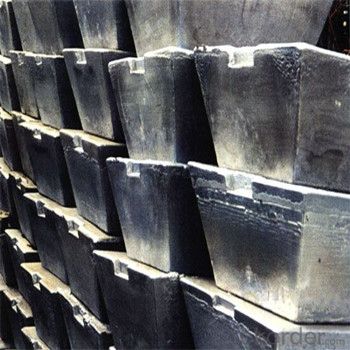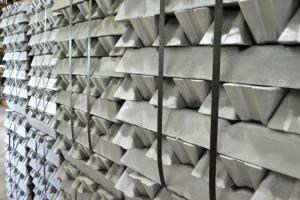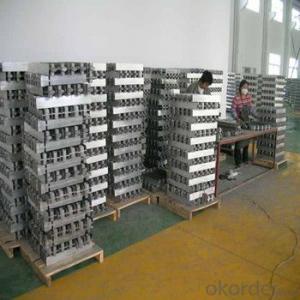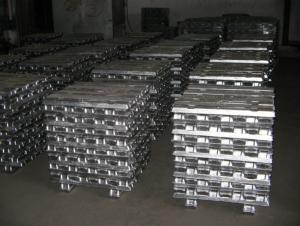Aluminium Ingots with High 99.99% Purity and Competitive Price
- Loading Port:
- China main port
- Payment Terms:
- TT OR LC
- Min Order Qty:
- 1000 m.t.
- Supply Capability:
- 10000 m.t./month
OKorder Service Pledge
OKorder Financial Service
You Might Also Like
Pure Aluminum Ingot Used for Industry
1.Structure of Aluminum Ingot Description
Aluminum Ingot is with the AL as the main chemical composition. Aluminum Ingot is used for industry,such as automobile,pinning and weaving,electron broadly and so on. Aluminum Ingot has the following advantages: easy control and operation, fast melting.
2.Main Features of the Aluminum Ingot
•High Purity
•Easy control and operation
•High strength
•Fast melting
•Competitive price
•Best Service
3. Aluminum Ingot Images


4. Aluminum Ingot Specification
Grade | Chemical Composition % | |||||||||
Al≥ | impurities ≤ | |||||||||
Si | Fe | Cu | Ga | Mg | Zn | Mn | others | Sum | ||
Al99.9 | 99.90 | 0.50 | 0.07 | 0.005 | 0.02 | 0.01 | 0.025 | - | 0.010 | 0.10 |
Al99.85 | 99.85 | 0.80 | 0.12 | 0.005 | 0.03 | 0.02 | 0.030 | - | 0.015 | 0.15 |
Al99.7 | 99.70 | 0.10 | 0.20 | 0.010 | 0.03 | 0.02 | 0.030 | - | 0.030 | 0.30 |
Al99.6 | 99.60 | 0.16 | 0.25 | 0.010 | 0.03 | 0.03 | 0.030 | - | 0.030 | 0.40 |
Al99.5 | 99.50 | 0.22 | 0.30 | 0.020 | 0.03 | 0.05 | 0.050 | - | 0.030 | 0.50 |
Al99.00 | 99.00 | 0.42 | 0.50 | 0.020 | 0.03 | 0.05 | 0.050 | - | 0.050 | 1.00 |
5.FAQ of Aluminum Ingot
We have organized several common questions for our clients,may help you sincerely:
①How about your company?
A world class manufacturer & supplier of castings forging in carbon steel and alloy steel,is one of the large-scale professional investment casting production bases in China,consisting of both casting foundry forging and machining factory. Annually more than 8000 tons Precision casting and forging parts are exported to markets in Europe,America and Japan. OEM casting and forging service available according to customer’s requirements.
②How to guarantee the quality of the products?
We have established the international advanced quality management system,every link from raw material to final product we have strict quality test;We resolutely put an end to unqualified products flowing into the market. At the same time, we will provide necessary follow-up service assurance.
③How long can we receive the product after purchase?
In the purchase of product within three working days, We will arrange the factory delivery as soon as possible. The pecific time of receiving is related to the state and position of customers.Commonly 7 to 10 working days can be served.
- Q: How are aluminum ingots used in the production of lighting fixtures?
- Due to their unique properties and versatility, aluminum ingots play a vital role in the manufacturing of lighting fixtures. The lightweight and durability of aluminum make it an ideal material for producing various components of lighting fixtures, such as the body, base, or frame. Its lightweight nature allows for easier installation and transportation, while its durability ensures the fixture's longevity. Furthermore, aluminum's excellent thermal conductivity is crucial for lighting fixtures as it helps dissipate heat generated by the bulbs. This property ensures that the fixture remains cool and prevents overheating, contributing to the safety and efficiency of the lighting system. Moreover, aluminum ingots can be easily molded into different shapes and sizes, allowing for the production of intricate and aesthetically pleasing lighting fixtures. This design flexibility enables manufacturers to cater to various consumer preferences, whether they prefer sleek and modern styles or classic and ornate designs. Moreover, aluminum's high corrosion resistance is particularly important for lighting fixtures that may be exposed to outdoor elements or high levels of moisture. This property guarantees that the fixture remains intact and maintains its appearance even under harsh conditions. Lastly, aluminum ingots are environmentally friendly as they can be easily recycled and have a low carbon footprint compared to other materials. This makes aluminum an appealing choice for lighting fixture manufacturers who prioritize sustainability and seek to reduce their environmental impact. In conclusion, the lightweight, durable, and thermally conductive properties of aluminum ingots, along with their versatility in design and environmental friendliness, make them indispensable in the production of lighting fixtures.
- Q: How is aluminium powder made into aluminium ingot?
- Usually out of the aluminum mill are aluminum ingots. Aluminum smelters are made from aluminium oxide and processed into aluminium ingots for sale.
- Q: What's the difference between aluminium ingot A380 and ADC12?
- Two kinds of material are different, mainly reflected in the silicon content above, A380 is the number of ADC12 is made, day number.
- Q: Can aluminum ingots be used in the production of musical instruments?
- Yes, aluminum ingots can be used in the production of musical instruments. Aluminum is a lightweight and durable metal that can be molded into various shapes, making it suitable for the construction of instrument bodies, parts, and accessories.
- Q: What is the process for smelting aluminum ingots?
- The process for smelting aluminum ingots involves several steps. First, bauxite ore, which is the primary source of aluminum, is mined and refined to remove impurities. The refined bauxite is then transformed into alumina through a process called the Bayer process. Next, the alumina is mixed with cryolite and other additives in a large electric furnace. This mixture is heated to extremely high temperatures, reaching around 1,800 degrees Celsius. The intense heat causes the alumina to melt and separate into aluminum and oxygen. The molten aluminum is then tapped from the furnace and transferred to a holding furnace or a ladle. During this stage, the aluminum is often alloyed with other metals to enhance its properties. Common alloying elements include magnesium, silicon, copper, and zinc. Once the desired alloy composition is achieved, the molten aluminum is poured into molds to form ingots. These molds are typically made of steel and can vary in size and shape depending on the specific requirements. After the aluminum has solidified and cooled, the ingots are removed from the molds and undergo further processing, such as heat treatment or rolling, to achieve the desired mechanical properties and shape. Overall, the process of smelting aluminum ingots involves mining and refining bauxite, transforming it into alumina, melting the alumina to separate aluminum and oxygen, alloying the molten aluminum, pouring it into molds, and finally processing the solidified ingots to achieve the desired properties.
- Q: What can aluminium ingots do?
- Cast aluminium and aluminum alloy are used to produce aluminium castings by casting method. Wrought aluminium and aluminium alloy are produced by pressure process. They are plates, belts, foils, tubes, rods, shapes, wires and forgings.
- Q: Can aluminum ingots be used in 3D printing?
- Yes, aluminum ingots can be used in 3D printing. Aluminum is a commonly used material in additive manufacturing processes such as selective laser melting (SLM) or direct metal laser sintering (DMLS). By melting the aluminum ingots and layering it in a precise manner, it is possible to create complex and durable 3D printed metal parts.
- Q: What are the challenges in recycling aluminum ingots?
- Recycling aluminum ingots presents several challenges that need to be addressed. To begin with, a major obstacle is the collection and sorting of aluminum waste. Unlike paper or plastic, aluminum waste is often mixed with other materials, making separation and sorting difficult. This necessitates the use of advanced sorting technologies and manual labor, which can be time-consuming and expensive. Additionally, the energy-intensive nature of aluminum production poses a challenge. Although recycling aluminum requires less energy than primary production, it still requires a significant amount of electricity. The process of melting down and purifying aluminum ingots requires high temperatures, which consume a considerable amount of energy. Furthermore, contamination is a persistent issue in recycling aluminum ingots. Even with advanced sorting technologies, it is difficult to guarantee that recycled aluminum is free from impurities. Contaminants like paint, coatings, or other metals can negatively impact the quality of the final product, making it less appealing to manufacturers. Moreover, transportation logistics present another challenge in the recycling process. Aluminum ingots are heavy and bulky, making their transportation from collection centers to recycling plants costly and challenging. This adds to the overall expenses of recycling. Lastly, the global market demand for recycled aluminum can fluctuate, making it challenging for recyclers to find buyers for their ingots. Economic factors, such as the price of primary aluminum and the demand for recycled materials in the market, can impact the profitability and feasibility of recycling aluminum ingots. Despite these challenges, recycling aluminum ingots remains a crucial practice due to its environmental benefits and the conservation of valuable resources. Continued research and innovation in recycling technologies can help overcome these challenges and make the process more efficient and cost-effective.
- Q: What is the difference between a aluminium ingot with and without a ticket?
- Beijing's purchase price is the price of aluminum, aluminum ingot + processing fees, billing is generally not a ton of processing fee will be about 400 yuan less, your price is overall, the overall profits can be, I think do not have to manage open ballot problem of aluminum ingots.
- Q: How can the sustainability practices in aluminum ingot production be enhanced?
- There are multiple ways to enhance sustainability practices in the production of aluminum ingots. To begin with, the environmental impact of the production process can be significantly reduced by adopting cleaner and more energy-efficient technologies. This could involve utilizing renewable energy sources like solar or wind power to operate the production facilities. Upgrading equipment and machinery to more energy-efficient models can also help lower energy consumption and minimize greenhouse gas emissions. Another effective approach is to optimize the recycling and reuse of aluminum scrap and waste materials. This can greatly reduce the need for producing new aluminum. By implementing efficient recycling programs and investing in advanced recycling technologies, a higher percentage of aluminum can be recovered from end-of-life products and reintroduced into the production process. This not only conserves valuable resources but also reduces the energy-intensive extraction and refining processes associated with primary aluminum production. Improving water management practices is also crucial for enhancing sustainability in aluminum ingot production. Implementing measures such as recycling and reusing water within the production process can help minimize water consumption. Additionally, installing wastewater treatment systems to remove pollutants and contaminants from discharged water can prevent water pollution and protect local ecosystems. Furthermore, sustainability in aluminum production can be enhanced by promoting transparency and responsible sourcing practices in the supply chain. This involves ensuring that raw materials like bauxite and alumina are obtained from responsible and sustainable mining practices. Implementing traceability systems and certification programs can help verify the origin and sustainability of these materials, ensuring compliance with ethical and environmental standards. Lastly, engaging with various stakeholders, including employees, local communities, and industry associations, is essential for fostering a culture of sustainability and driving continuous improvement in aluminum ingot production. This can be achieved through regular training and awareness programs on sustainable practices, as well as collaborating with suppliers and customers to identify and implement innovative sustainability solutions. Overall, enhancing sustainability practices in aluminum ingot production requires a comprehensive approach that encompasses technological advancements, efficient resource management, responsible sourcing, and stakeholder engagement. By implementing these measures, the aluminum industry can reduce its environmental impact and contribute to a more sustainable future.
Send your message to us
Aluminium Ingots with High 99.99% Purity and Competitive Price
- Loading Port:
- China main port
- Payment Terms:
- TT OR LC
- Min Order Qty:
- 1000 m.t.
- Supply Capability:
- 10000 m.t./month
OKorder Service Pledge
OKorder Financial Service
Similar products
Hot products
Hot Searches
Related keywords




























